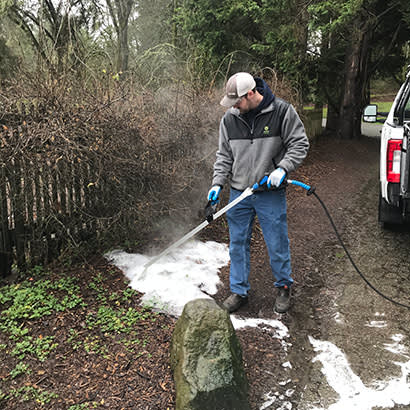
Park and recreation professionals across the country are working to ensure their agencies adopt best practices that safeguard the public’s health. One recent topic that is being debated across the field is the use of products containing glyphosate in parks, considering that the International Agency for Research on Cancer recently classified the chemical as “probably carcinogenic to humans.” To address the potential health threat posed by glyphosate, many agencies are reducing or eliminating their use of glyphosate products to ensure everyone has access to safe and healthy spaces. Not only does this shift in practice address the health of both park staff and their communities by reducing or eliminating their exposure to the chemical, but also it supports healthier environments for wildlife, such as pollinators and aquatic life. As municipalities are restricting or banning these chemicals to promote healthier spaces, they need to source alternatives to help deal with the weed issues the chemicals have been increasingly relied on to address. Seattle is one municipality that is implementing more glyphosate-free solutions on its public lands.
Seattle Goes Glyphosate-Free
In Seattle, RoundUp — which contains glyphosate — was previously the most used herbicide by city gardeners and maintenance staff. In 2019, prompted by environmental and public health concerns, Seattle restricted the use of herbicides containing glyphosate on public land. The city’s Integrated Pest Management (IPM) program reclassified glyphosate as a Tier 1 product, meaning that its use requires rigorous review and approval from the city’s IPM interdisciplinary team (IDT).
The restriction poses a significant challenge to Seattle Parks and Recreation, which manages 6,414 acres of parkland (11 percent of Seattle’s area). Its parkland is divided between undeveloped areas (40 percent) and developed parks (60 percent), and RoundUp has been an important tool in both. (It should be noted that Seattle Parks and Recreation has never used herbicides on lawn areas or athletic fields, or near children’s play areas or water bodies.) While different types of landscapes have different public uses and receive different levels of maintenance, RoundUp previously provided a single go-to method for weed control. Moving forward, we are seeking effective alternatives to herbicide use, and are currently implementing three methods: (1) treat the weed, (2) pull it out and (3) heat it up.
Treat the Weed
The IDT’s list of herbicide options includes products containing the active ingredients imazapyr and triclopyr. These products, like glyphosate, are highly effective in controlling the entire weed: once applied, they translocate throughout the plant, including the roots. We expect to expand our use of imazapyr and triclopyr products. However, there are lingering concerns in the community and among staff about the use of any non-organic chemical options. The IDT continues to explore and evaluate other reduced-risk options for direct treatment. For instance, plant oils can be applied to control weeds.
Pull It Out
While weeds always can be removed manually, few municipalities can provide enough gardening and maintenance staff to manage weedy landscapes with manual removal alone. Another factor is how physically taxing this work is for staff.
Manual weed control can be useful, though, when augmented by applying wood-chip mulch after removal, to prevent re-emergence. With the benefit of large amounts of readily available arborist-chip mulch, Seattle has found this strategy effective.
Heat It Up
Heat-based weeding devices — using either propane flame or hot water and foam — warm plants until they degrade and disintegrate. Seattle is testing these devices in limited areas.
Flame weeding carries the risks of fires, burns and smoke inhalation. All staff using these devices must be thoroughly trained to minimize risks.
We have used hot water and foam devices with good results in city landscapes for the past several years, and believe they show great promise. These devices use a low-pressure process that combines heated water with biodegradable foam made from plant material. When the heated mixture is applied, the foam holds heat on the target weed, allowing cell degradation and desiccation to occur. When the foam cools, the area is safe for people and animals. This environmentally friendly, herbicide-free alternative allows persons without pesticide licenses to do the work that previously could be done only by license holders.
Heat treatments have far broader potential for applications, particularly in difficult-to-maintain landscapes, such as lidded reservoirs, athletic fields, gravel walking trails, pesticide-free parks, bioswales and other stormwater infrastructure.
Since glyphosate had become a major part of Seattle’s weed control, the shift to using other methods has required work to adjust successfully. But, this also creates an opportunity for staff teams and managers to get back to the basics of IPM and refresh all staff thinking and practices around appropriate, safe and healthy weed control methods.
Patti Bakker is Interim Natural Resources Unit Manager at Seattle Parks and Recrreation.

